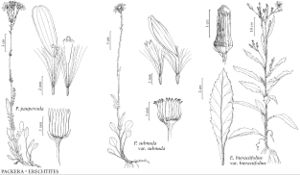Erechtites
Fl. Ludov., 65. 1817.
| Taxon | Illustrator ⠉ | |
|---|---|---|
 | Packera paupercula Packera subnuda var. subnuda Erechtites hieraciifolius var. hieraciifolius | Linny Heagy Linny Heagy Linny Heagy |
Annuals or perennials (often with rank, pungent odor), mostly 20–200 cm (taprooted; glabrous or ± tomentose or villous, often unevenly glabrescent). Stems usually 1, usually erect. Leaves basal and cauline; alternate; petiolate or sessile; blades pinnately nerved, mostly ovate to lanceolate (sometimes pinnately lobed or dissected), ultimate margins entire, denticulate, or toothed, faces glabrous or ± tomentose or villous (often unevenly glabrescent). Heads disciform, in cymiform or corymbiform arrays. Calyculi of 1–6 [–12+] bractlets. Involucres urceolate or cylindric to turbinate, 2–10+ mm diam. Phyllaries persistent, usually (5), 8, 13, or 21 in 1–2 series, erect (sometimes reflexed in fruit), distinct (margins ± interlocking), lanceolate to linear, equal, margins ± scarious (tips green or with minute dark spots). Receptacles flat to convex, ± foveolate or smooth, epaleate. Ray-florets 0. Peripheral (pistillate) florets 10–100+ (in 1–3+ series), corollas whitish to pale-yellow, tubular-filiform, lobes 4–5, deltate, erect. Disc-florets (3–) 10–20 (–50+), mostly bisexual and fertile, inner sometimes functionally staminate; corollas whitish to pale-yellow [pinkish], tubes longer than funnelform throats, lobes 4–5, erect to spreading, lanceovate; style-branches stigmatic in 2 lines, apices truncate-penicillate. Cypselae (stramineous to brown or purple) ± prismatic and 5-angled or ribbed or ± obovoid to ± fusiform and 10–20-nerved, glabrous or puberulent (on or between ribs or nerves); pappi readily falling, of 60–120, white [reddish], barbellulate bristles. x = 20.
Distribution
North America, West Indies, South America, Pacific Islands (New Zealand), Australia, some species widely scattered as weeds
Discussion
Species ca. 12 (3 in the flora).
The name Erechtites has been treated traditionally as grammatically feminine; the International Code of Botanical Nomenclature (Art. 62.4) notes that generic names ending in “-ites” are to be treated as masculine. Specific and infraspecific epithets are here presented in the masculine gender.
Selected References
Key
| 1 | Involucres urceolate or obconic, 10–17 mm; phyllaries usually 21; receptacles 5–12+ mm diam | Erechtites hieraciifolius |
| 1 | Involucres cylindric or turbinate, 4–7 mm; phyllaries usually 8 or 13; receptacles 3–5(–6) mm diam | > 2 |
| 2 | Leaves lobed or pinnatifid; phyllaries usually 13 | Erechtites glomeratus |
| 2 | Leaves entire or dentate (not lobed or pinnatifid); phyllaries usually 8 | Erechtites minimus |